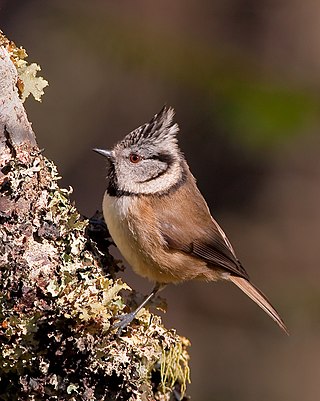
The tits, chickadees, and titmice constitute the Paridae, a large family of small passerine birds which occur mainly in the Northern Hemisphere and Africa. Most were formerly classified in the genus Parus.
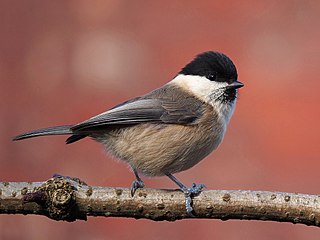
The willow tit is a passerine bird in the tit family, Paridae. It is a widespread and common resident breeder throughout temperate and subarctic Europe and across the Palearctic. The plumage is grey-brown and off-white with a black cap and bib. It is more of a conifer specialist than the closely related marsh tit, which explains it breeding much further north. It is resident, and most birds do not migrate.

Coenraad Jacob Temminck was a Dutch aristocrat, zoologist and museum director.

The grey-headed chickadee or Siberian tit, formerly Parus cinctus, is a passerine bird in the tit family Paridae. It is a widespread resident breeder throughout subarctic Scandinavia and the northern Palearctic, and also into North America in Alaska and the far northwest of Canada. It is a conifer specialist. It is resident, and most birds do not migrate. Curiously, the bird has no grey on its head, which is black, white, and brown.

Hermann Schlegel was a German ornithologist, herpetologist and ichthyologist.

The mountain chickadee is a small songbird, a passerine bird in the tit family Paridae.

The Mexican chickadee is a small songbird, a passerine bird in the tit family Paridae. It is still often placed in the genus Parus with most other tits, but mtDNA cytochrome b sequence data and morphology suggest that separating Poecile more adequately expresses these birds' relationships. The American Ornithologists' Union had been treating Poecile as distinct genus for some time already.

The warbling white-eye, also known as the Japanese white-eye and mountain white-eye, is a small passerine bird in the white-eye family. The specific epithet is occasionally written japonica, but this is incorrect due to the gender of the genus. Its native range includes much of East Asia, including the Russian Far East, Japan, Indonesia, Korea, and the Philippines. It has been intentionally introduced to other parts of the world as a pet and as pest control, with mixed results. As one of the native species of the Japanese islands, it has been depicted in Japanese art on numerous occasions, and historically was kept as a cage bird.

The white-fronted tit is a species of bird in the family Paridae. It is endemic to the Philippines found in the islands of Luzon and Mindanao. Its natural habitat is tropical moist lowland forests. It is threatened by habitat loss.

The white-browed tit is a species of bird in the tit family Paridae. It is endemic to the mountain forests of central China and Tibet.

Poecile is a genus of birds in the tit family Paridae. It contains 15 species, which are scattered across North America, Europe and Asia; the North American species are the chickadees. In the past, most authorities retained Poecile as a subgenus within the genus Parus, but treatment as a distinct genus, initiated by the American Ornithologists Union, is now widely accepted. This is supported by mtDNA cytochrome b sequence analysis.
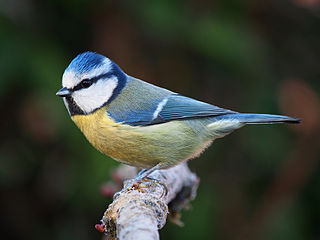
Cyanistes is a genus of birds in the tit family Paridae. The genus was at one time considered as a subgenus of Parus. In 2005 an article describing a molecular phylogenetic study that had examined mitochondrial DNA sequences from members of the tit family, proposed that a number of subgenera including Cyanistes be elevated to genus status. This proposal was accepted by the International Ornithologists' Union and the British Ornithologists' Union.

Pardaliparus is a genus of birds in the tit family. The members of the genus were formerly included in Parus but were moved to Pardaliparus when Parus was split into several resurrected genera following the publication of a detailed molecular phylogenetic analysis in 2013.
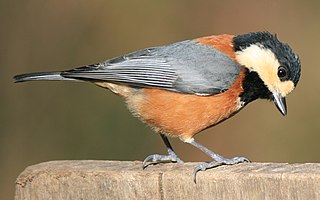
Sittiparus is a genus of birds in the tit family Paridae. The species in the genus were formerly included in Parus but were moved to Sittiparus when Parus was split into several resurrected genera following the publication of a detailed molecular phylogenetic analysis in 2013. The genus Sittiparus had originally been erected by the Belgium politician and naturalist Edmond de Sélys Longchamps in 1884 with the varied tit as the type species.

Fauna Japonica is a series of monographs on the zoology of Japan. It was the first book written in a European language (French) on the Japanese fauna, and published serially in five volumes between 1833 and 1850.

The Sichuan tit is a species of bird in the tit family Paridae. It is found in central China.

Owston's tit is a small passerine bird in the tit family Paridae that is endemic to the southern Izu Islands south of Japan, occurring only on the islands of Miyakejima, Mikurajima and Hachijojima.
The Iriomote tit is a small passerine bird in the tit family Paridae. It is endemic to the Yaeyama Islands which lie to the south west of Japan and to the east of Taiwan. Iriomote is the name of the largest island in the group.
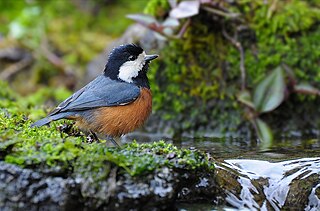
The chestnut-bellied tit is a small passerine bird in the tit family Paridae that is endemic to Taiwan.

Orii Hyōjirō was a Japanese specimen collector of birds and mammals. At least a hundred new species and subspecies were described based on the type specimens he collected, a 2014 review putting the total, among taxa currently recognized, at 14 species and 41 subspecies of mammal, and 6 species and 68 subspecies of bird. The 7 mammal and 10 bird taxa named in honour of "Orii of the Orient", as he came to be known, include the Ryūkyū shrew and now-extinct Daitō varied tit.




















